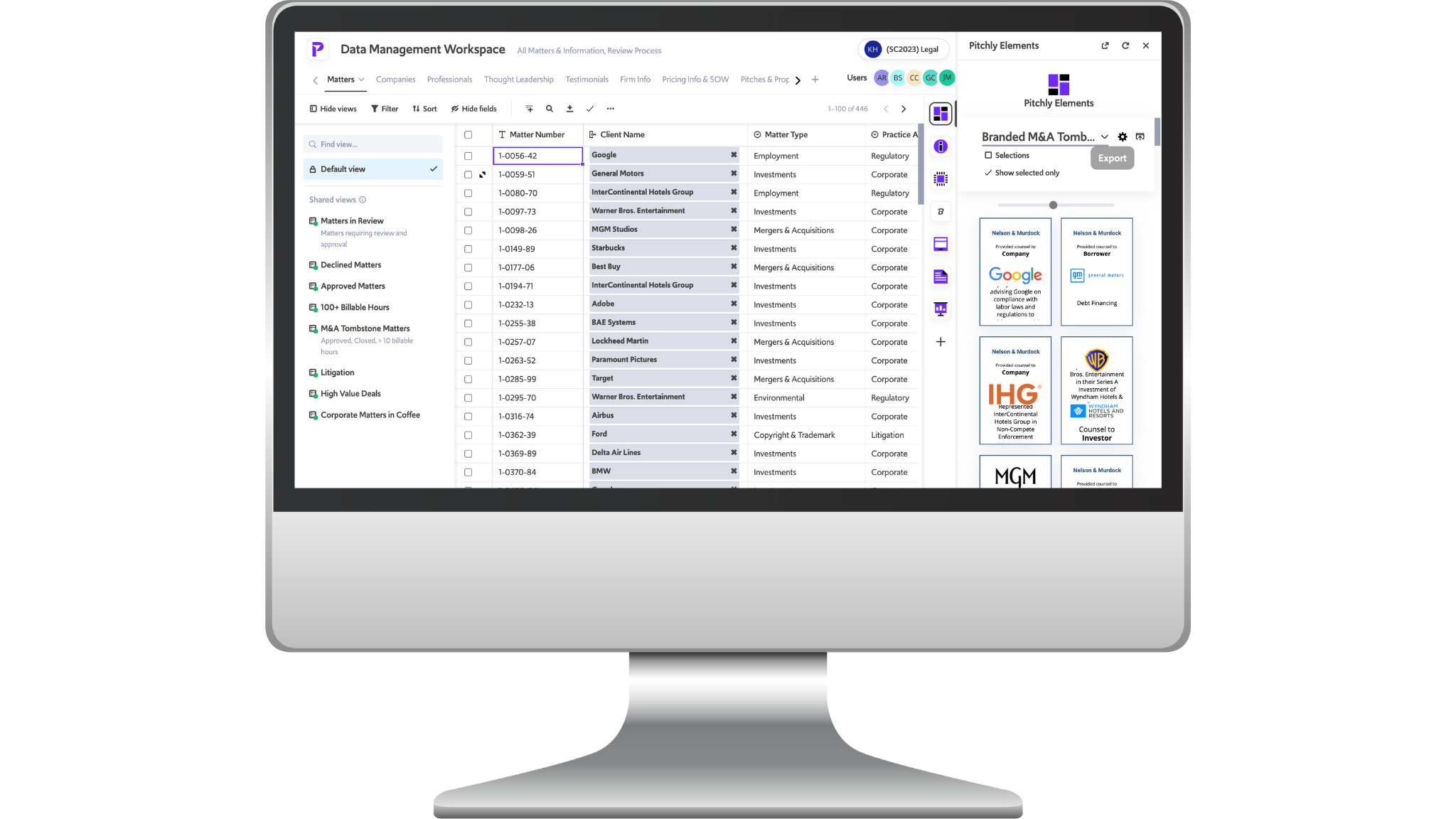The Legal Pitch that Seals Deals
The Ultimate 5-Step Guide to Prepping for Legal Services Pitching
With the need for legal services only growing year-over-year and the competition between law firms only getting more intense, the need for an incredible pitching process is more pressing than ever. Nailing this process can be make or break for your firm’s success.
The fact is that pitching is largely a numbers game. Only about 20% of pitches actually lead to new business, on average. This means that the majority of the numerous hours and manpower put into crafting pitches often go to waste. And with shrinking budgets and staffing challenges for legal marketing and BD teams, this is a resource sink that law firms simply cannot afford.
However, it is not as bleak as one may be led to believe. That 20% can easily be boosted by addressing many of the typical pitfalls of legal pitches. The norm is: not engaging, not targeted, wordy, long, and unmemorable. If your firm is able to combat these weaknesses, you will be leaps and bounds ahead of the competition and positioned to win new clients.
In this guide, we’ll walk you through the 5 steps to creating craft the ultimate legal services pitch to seal the deal.
5 Steps to a Successful Legal Pitch
- Get to know your audience through pre-pitch research
- Create visual consistency
in your deck to ensure memorable branding - Keep it simple & targeted
to maximize time & impact - Prove your relevant experience
to boost social proof - Prep your pitch team
to ensure the delivery is the cherry on top of a great pitch
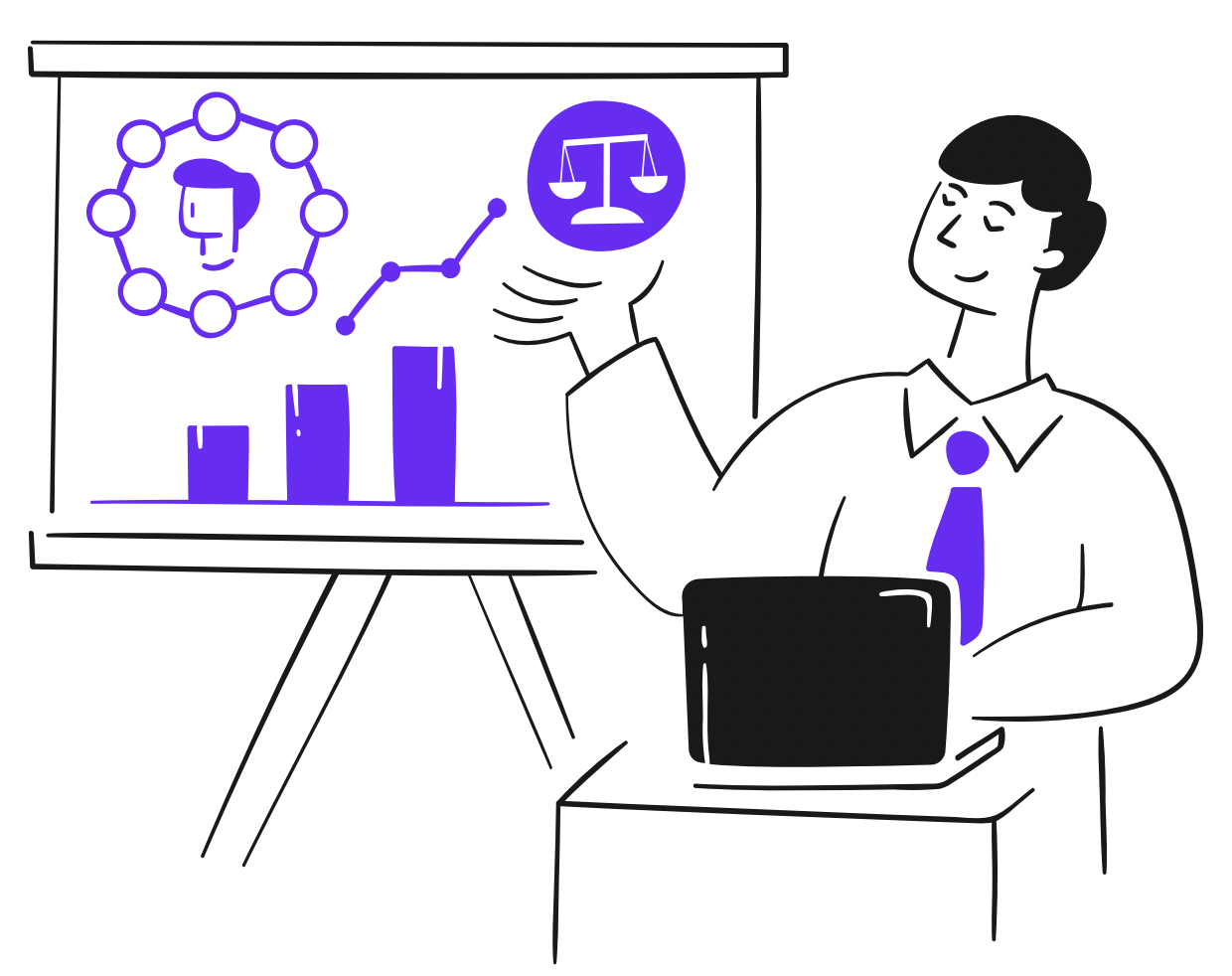
 Step 1:
Step 1:
Get to know who you're pitching to
The first step in the pitching process begins before anyone even walks into the room. As a marketer, you know this, but the lawyers often skip this step, leaving you to create a pitch that is not targeted. Doing your own research to get to know the company and the individuals the firm is pitching to will help to guide and perfect your entire presentation.
A recent survey found that every CMO is aware that customized proposals are the key to sealing the deal. And yet, only about 60% of marketing/business development teams currently take steps to personalize their pitches. And while this is in part due to time and resource constraints, it is an investment that has a proven ROI.
You cannot copy and paste your pitch from company to company. Your audience is likely sitting through meeting after meeting getting pitched at, so making sure every single detail is relevant to them ensures that their attention is always peaked, and that they leave the room not feeling pitched at, but collaborated with.
Here are some great ways to check this pre-pitch research off your to-do list:
- Sift through the company website, news sites, and public filings with a fine-toothed comb to identify company history, goals, values and current initiatives.
- If you know you will be in the room with the lawyers, do a quick search on LinkedIn to see what topics they care about, their job history and mutual connections, and use your firm’s CRM to understand Who Knows Whom.
- Compile any needs or pains revealed in your pre-pitch correspondence and share it with the pitch team.
- If your firm has an Experience Management Platform, look at similar organizations the firm has worked with in the past and identify any similarities that you may be able to extract valuable insight from.
- Consider the cultural implications that may be at play. If you’re meeting with an international audience, it’s worth researching the norms around business meetings/pitches such as format and timing.
The ultimate reason for this research is to increase your odds of establishing a relationship.
Studies find that on average, people make 84% of decisions based on emotion alone, while analysis only accounts for 16% of decisions. While the difference between the actual services you and your competitors provide may not be starkly distinct, these pitches can help teams decide who they could see themselves enjoying working with. So doing this research before you craft your pitch will empower you to be more empathetic and connect with your audience better to really seal the deal.
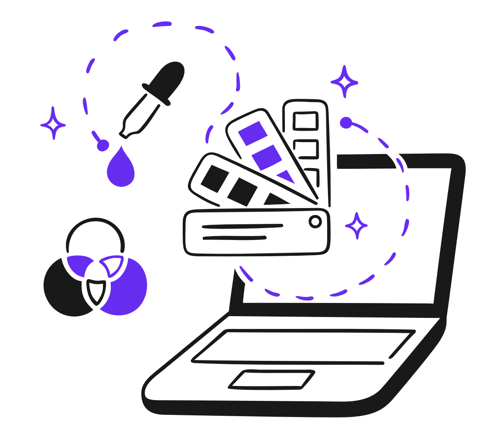 Step 2:
Step 2:
Reinforce your message and brand with visual consistency
The visual identity of your pitch presentation is not only what can help to create a really positive first impression, but it’s also an opportunity to make your presentation and your firm in general stickier in your audience’s minds.
While your visual presentation, usually in the form of a PowerPoint deck, is simply a guide for your pitch and not a substitution for the spoken pitch, its impact on the ability to seal deals is undeniable. However, this can often be a major downfall for a lot of legal pitch teams.
As pitches are being created, they’re squeezed by time restraints, going through several rounds of revisions and likely being passed back and forth between several team members. This can lead to branding mishaps like different font colors throughout the same presentation, off-kilter spacing, different size logos, and more.
And even if these errors aren’t happening on an individual presentation level, there may be large variances among all of the pitch presentations passing from your firm to the prospective company you’re targeting. This all contributes to an inconsistent brand experience. And the result of this will create an unmemorable experience at best, and a lasting reputation of being disorganized at worst. Both of these possibilities can cost your firm a deal.
If your firm is creating multiple pitch decks on a regular basis, going through a tedious checklist for each one may quickly become unsustainable. That’s why many firms invest in technology that generates content from templates. Not only will it make the process easier, but it will also make it harder for branding inconsistencies to go unnoticed.
Pitchly’s Data Enablement Platform makes it seamless to go from data collection to filtering to content generation. And with our integration with Templafy’s Content Enablement Platform, you can add even more power to your automated, dynamic pitch deck processes.

If you don't have a process to automate content generation, here's a checklist to go through with your deck before you audience lays eyes on it:
-
Is the brand font being used?
-
Are all like slides in the same layout?
-
Is all contact information up-to-date?
-
Are all logos up-to-date?
-
Is your logo present on each slide?
-
Are all team bios current?
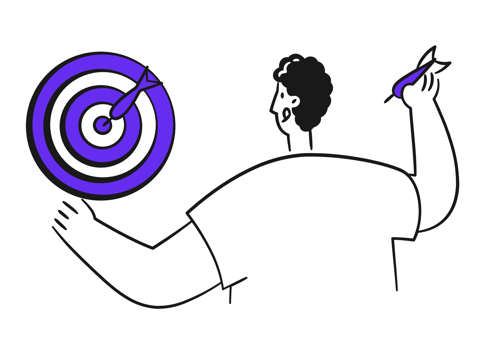 Step 3:
Step 3:
Keep it simple and targeted
Many pitches are too long and filled with lots of jargon. While much of this fluff can be cut out by putting the research you did in step one into action, keeping your presentation concise and targeted is a skill that requires fine tuning.
One individual who serves as in-house counsel, and receives more pitches than he cares to think about, said that the best pitch he ever received was more like how they do it in Silicon Valley - short and to the point. It was a mere 13 slides and only covered the team he’d be working with, a look at their suggested strategy and the anticipated cost.
There’s no reason for your pitch presentation to drag on and on. What you think may be relevant to share may be simply another minute out of your audience’s day that they can’t be working on pressing tasks. Put yourselves in their shoes and include what you’d want to hear and understand about the pitch - and no more. Most of the content that is included in a pitch deck is easily found on your firm’s website.
Here are tips on how to keep your presentation targeted and effective:

Use straightforward language free of overly jargon-y words so that people do not zone out or perceive your team as pretentious

Repeat key takeaways consistently throughout your presentation so that they're hard to miss and will stick in your audience's minds

Make the main underlying theme of your presentation your firm's "special sauce" or the main differentiating factor between you and your competition
 Step 4:
Step 4:
Prove your experience
Social proof is important in almost every single purchase a person makes. But when it comes to large financial decisions such as hiring a legal team, it’s essential. 68% of legal consumers rely on reviews and 42% on recommendations when scouting out potential options. This gives people the confidence they need to engage your firm if they are able to lean on the trust and decisions of other organizations similar to them. Highlighting other clients you’ve worked with and what you were able to accomplish with them is what can instill this trust.
While many teams opt to wait until the end to show experience in the form of content like tombstones, the best plan of attack is to hint at your experience throughout the entire presentation. Often this social proof is the first major barrier that your audience may overcome before making a decision, so giving them fuel from the beginning will be in your best interest.
Weave in testimonials, logos and brief case studies to show your prospective clients the value of working with your firm.
One of the best ways to visualize your experience is through tombstones.
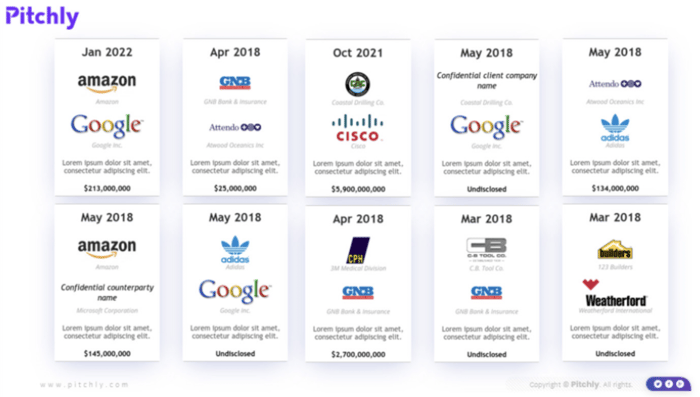
Effectively communicate your experience credentials with tombstones generated by Pitchly's Data Enablement Platform
These are visual presentations of similar and relevant client work that you’ve completed in the past. While many firms use tombstones to highlight transactional work, they can be customized for litigation matters, as well.
Here are some tips for making sure that your tombstones can help push your audience to choosing your firm:
- Keep them up-to-date to ensure that you’re taking advantage of all the best and most accurate data you have.
- Customize which tombstones you display to fit the needs, priorities and industry of the organization you’re pitching.
- Get detailed by displaying relevant information such as deal size, industry, type of transaction, client/counterparty, etc.
This process can easily become very time-consuming as the number of pitches you give grows, especially if you focus on customizing each deck for your audience. The buffer against this time sink is by picking the right software to automate the process.
The Senior Bids Manager at Fieldfisher, Anna Maysey-Wells, shared that “firms that don’t utilize pitch technology within the next 2 years will be left behind” due to the time-saving advantage it gives you.
Software like Pitchly helps you automate the tombstone generation process by centralizing all of your previously disparate experience data in a single place, making it easy to filter for relevant information, and giving you the ability to instantly export to PowerPoint slides or Word docs.

Pitchly's tombstone builder interface enables formatting changes (no designer needed)
To see more about how our tombstone builder works, you can watch this quick, 1-minute demo.
Step 5:
Prepping your pitch team
While doing all of the pre-pitch preparation such as effectively researching your audience, optimizing your branding, making your presentation documents concise and giving people social proof to latch onto are crucial for an effective pitch, the ability to seal the deal ultimately hinges on your lawyers’ delivery in the room.
Preparing your team is the last step in making sure that the great pitch presentation you’ve created gets the attention it deserves – and makes it easy for your pitch team to shine!

Getting the timing right
The people being pitched are busy; the last thing they want to do is sit through a long pitch meeting with a law firm team that isn’t well-prepared. Ensuring that your team doesn’t go over the time allotted is paramount. If they’re cut off at a hard stop with a few slides left, they can’t make a strong close. And a final impression or wrap-up is arguably as important as a first impression. Not being able to wrap things up powerfully can sabotage their entire pitch and potentially cost your firm the business.
A good rule of thumb is to plan for the presentation to come in under the time allotted – if they have a 30-minute slot on their prospect’s calendar, make sure the team can finish in 20 minutes to leave some time for questions, deeper dives into topics that pique the audience’s interest and so on. You can of course put some additional content in your pitch team’s back pocket in case they end up with extra time. While lawyer time is hard to come by, if you can get them to practice, they will be miles ahead of any competitors.

Building chemistry
As we discussed earlier, the most important component in a person’s decision-making process is their emotions. And the delivery of the pitch can go a long way in activating these positive emotions by forming a connection with your prospects.
One of the main ways to do this is to encourage your team to not be scared of showing their personality. It goes without saying to “read the room” and match the same tone of the audience - whether that seems more casual and relaxed or more buttoned-up. But either way, it’s not interesting for an audience to watch someone who’s seeming like a pre-programmed robot – or reading from slides. A smile, relaxed body language and presentations that clearly have a bit of personality weaved in can go a long way in building trust and comfort.
Another crucial step to building chemistry with an audience is to allow for questions throughout, not just at the very end. This makes the presentation more conversational, rather than a lecture. It’s also important to ask the audience questions. Oftentimes, the only time that people who are being pitched are asked questions is when they’re rhetorical. If your team asks engaging questions, the audience will feel more of a part of the presentation, and they will end up with a more relevant and targeted pitch.

When pitching as a team
Often, a pitch team is comprised of more than one person. This can allow each team member to shine in the lane that they dominate. But it can also introduce some additional complications. This is the potential client’s first impression of the team they could potentially be working with, so you want them to perceive a smooth and effective working dynamic.
This can manifest in both large and subtle ways. Have your team be aware of the ways that they transition from one team member to the next, ensuring that it does not appear as if one person has to fight their way into the spotlight. Also make sure they’re cognizant of what they’re doing when not speaking. If someone else has the floor, they should still be engaged and interested in what they’re saying, not simply waiting for their turn to speak - or worse, looking at their phones.
.png)
Get ready to deliver pitches that seal deals
Pitching is a crucial component of legal marketing, and without proven and consistent processes, it’s impossible for a firm to achieve scalable growth. But if you put these tips into action, your firm will be positioned to win new business more easily. And that puts you a step ahead of the competition.
Consider though that your pitch success starts at the moment that you understand and activate your experience data. With a robust and reliable experience management platform like Pitchly, it’s easier to utilize your complete experience data set and filter for relevant information for each pitch, create on-brand decks and export instantly to a variety of document platforms.
Want to learn more about how Pitchly can reduce the time it takes you to generate pitch content by 93%, leaving more time to perfect your pitch? Watch a quick, 3-minute walkthrough of our capabilities that help legal marketers, or schedule some one-on-one time with our team.
About Pitchly
Pitchly was founded on the belief that the future of work is data-driven, not task-driven. With a focus on solving the last mile dilemma for business data, Pitchly has created a place where people, data and content come together to generate real business outcomes.
Pitchly’s data productivity suite of applications, extensions, and integrations empowers collaboration, automation and bottom-line value.
Visit us online at www.pitchly.com.
